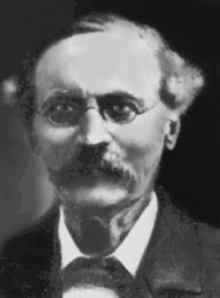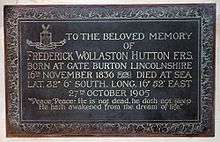Frederick Hutton (scientist)
Captain Frederick Wollaston Hutton FRS (16 November 1836 – 27 October 1905) was an English-New Zealand scientist who applied the theory of natural selection to explain the origins and nature of the natural history of New Zealand. An army officer in early life, he then had an academic career in geology and biology. He became one of the most able and prolific nineteenth century naturalists of New Zealand.
Frederick Hutton FRS | |
|---|---|
 | |
| Born | Frederick Wollaston Hutton 16 November 1836 Gate Burton, Lincolnshire, England |
| Died | 27 October 1905 Died at sea |
| Resting place | Buried at sea off Cape Town, South Africa |
| Awards | Fellow of the Royal Society (1892), Clarke Medal (1891) |
| Scientific career | |
| Institutions | Colonial Museum, Wellington (1871–1873); Otago Museum, Dunedin (1874–1879); and the Canterbury Museum, Christchurch (1887–1905) |
Biography

Hutton was born in Gate Burton, Lincolnshire, England and passed through Southwell Grammar school and the Naval Academy at Gosport, Hampshire. He studied applied science at King's College London before being commissioned in the Royal Welch Fusiliers and fighting in the Crimean War and the Indian Mutiny.[1]
Hutton returned to England in 1860, and continued to study geology at Sandhurst, being elected to the Geological Society of London in the same year. Hutton married Annie Gouger Montgomerie in 1863, and resigned his commission in 1866 to travel with his wife and two children to New Zealand, where four more children would follow. They lived initially in Waikato, where Hutton tried his hand at flax milling, but he soon changed back to geology, joining the Geological Survey of New Zealand in 1866 and becoming Provincial Geologist of Otago in 1874. At the same time, he was made lecturer in geology at the University of Otago and curator of the museum there.[2] Hutton became professor of biology at Canterbury College in 1880, and was elected a Fellow of the Royal Society in 1892.[3] The following year, he also took on the curatorship of the Canterbury Museum. Towards the end of his life, Hutton was made president of the Royal Australasian Ornithologists Union. He was awarded the Clarke Medal by the Royal Society of New South Wales in 1891. He was the first President of the New Zealand Institute (which later became the Royal Society of New Zealand), from 1904 to his death in 1905; he was followed by Sir James Hector.[4] He was one of the inaugural vice-chairmen of the New Zealand Alpine Club, which was founded in July 1891.[5]
He worked successively at the Colonial Museum, Wellington (1871–1873); Otago Museum, Dunedin (1874–1879);[6] and the Canterbury Museum, Christchurch (1887–1905).
Hutton died on the return voyage on the SS Rimutaka from England on 27 October 1905, and was buried at sea off Cape Town, South Africa.[7] He is commemorated in the Hutton Memorial Medal and Research Fund, awarded for scientific works bearing on the zoology, botany or geology of New Zealand. Hutton's shearwater (Puffinus huttoni), a sea bird, was named after him.
Evolution
In 1860, he wrote a supportive review of Charles Darwin's On the Origin of Species for the journal, The Geologist.[8] In 1861, he wrote an article defending Darwinism in the same journal.[9] Hutton defended Darwin from the criticisms of creationist Adam Sedgwick, which he described as "gross ironical misrepresentations". He wrote that creationism was a "mere assertion, an evasion of the question, a cloak for ignorance."[8]
Throughout his life, Hutton remained a staunch exponent of Darwin's theories of natural selection, and Darwin himself expressed his appreciation in a letter to Hutton.[8]
Taxa
Taxa described and named by Hutton include:
- Cabalus modestus (Hutton, 1872) – the Chatham rail
- Callochiton empleurus (Hutton, 1872) – a chiton
- Ericentrus rubrus (Hutton, 1872) – the orange clinid
- Phosichthys argenteus Hutton, 1872 – a lightfish
- Stegnaster inflatus (Hutton, 1872) – a sea star
- Bittium exile (Hutton, 1873) – a marine snail
- Colistium guntheri (Hutton, 1873) – the New Zealand brill
- Comitas trailli (Hutton, 1873) – a marine snail
- Dentalium nanum Hutton, 1873
- Herpetopoma bella (Hutton, 1873) – a marine snail
- Margarella antipoda rosea (Hutton, 1873) – a subspecies of marine snail
- Margarella fulminata (Hutton, 1873) – a marine snail
- Novastoa lamellosa (Hutton, 1873) – a marine snail
- Pterotyphis eos (Hutton, 1873) – a marine snail
- Pterotyphis zealandicus (Hutton, 1873) – a marine snail
- Pupa kirki (Hutton, 1873) – a marine snail
- Rhombosolea retiaria Hutton, 1873 – the black flounder
- Scorpis violacea (Hutton, 1873) – the blue maomao
- Thoristella chathamensis (Hutton, 1873) – a marine snail
- Trichosirius inornatus (Hutton, 1873) – a marine snail
- Uberella vitrea (Hutton, 1873) – a marine snail
- Xymene plebeius (Hutton, 1873) – a marine snail
- Xymene traversi (Hutton, 1873) – a marine snail
- Zeacolpus symmetricus (Hutton, 1873) – a marine snail
- Zeacolpus vittatus (Hutton, 1873) – a marine snail
- Jasus edwardsii (Hutton, 1875) – a spiny lobster
- Paratrachichthys trailli (Hutton, 1875) – the sandpaper fish or common roughy
- Bidenichthys consobrinus (Hutton, 1876) – the grey brotula or orange cuskeel
- Anomia trigonopsis Hutton, 1877 – a marine bivalve
- Notolabrus cinctus (Hutton, 1877) – the girdled wrasse
- Eudyptes filholi Hutton, 1878 – the eastern rockhopper penguin
- Leuconopsis obsoleta (Hutton, 1878) – a land snail
- Proxiuber australe (Hutton, 1878) – a marine snail
- Proxiuber hulmei (Hutton, 1878) – a marine snail
- Thoristella oppressa (Hutton, 1878) – a land snail
- Gallirallus philippensis macquariensis (Hutton, 1879) – the Macquarie Island rail
- Pseudaneitea papillata (Hutton, 1879) – a slug
- Patelloida corticata (Hutton, 1880) – a limpet
- Latiidae Hutton, 1882 – a family of freshwater molluscs
- Cytora calva (Hutton, 1883) – a land snail
- Cytora pallida (Hutton, 1883) – a land snail
- Cytora pannosa (Hutton, 1883) – a land snail
- Homalopoma fluctuata (Hutton, 1883) – a marine snail
- Lamellaria cerebroides Hutton, 1883 – a marine snail
- Rhytida australis Hutton, 1883 – a land snail
- Rhytida citrina Hutton, 1883 – a land snail
- Rhytida patula Hutton, 1883 – a land snail
- Fossarina rimata (Hutton, 1884) – a marine snail
- Micrelenchus caelatus (Hutton, 1884) – a marine snail
- Otoconcha Hutton, 1884 – a land snail genus
- Leuconopsis Hutton, 1884 – a land snail genus
- Microvoluta marginata (Hutton, 1885) – a marine snail
- Powelliphanta lignaria (Hutton, 1888) – a land snail
- Argosarchus Hutton, 1898 – a stick insect genus
- Hemideina ricta (Hutton, 1896) – a tree weta
- Paprides armillaus (Hutton, 1897) – an alpine grasshopper
- Paprides australis (Hutton, 1897) – an alpine grasshopper
- Paprides torquatus (Hutton, 1897) – an alpine grasshopper
Hutton's publications
- 1871: Catalogue of the Birds of New Zealand, with Diagnoses of the Species
- 1872: Fishes of New Zealand, Catalogue with Diagnoses of the Species (by Hutton) and also includes Notes on the Edible Fishes of New Zealand (by James Hector)
- 1873: Catalogue of the Marine Mollusca of New Zealand, with Diagnoses of the Species
- 1873: Catalogue of the Tertiary Mollusca and Echinodermata of New Zealand in the Collection of the Colonial Museum
- 1875: Report on the geology & gold fields of Otago by Hutton and George Henry Frederick Ulrich, with appendices by J.G. Black and James McKerrow
- 1880: Manual of the New Zealand Mollususca. A systematic and descriptive catalogue of the marine and land shells, and of the soft mollusks and Polyzoa of New Zealand and the adjacent islands.
- 1881: Catalogues of the New Zealand Diptera, Orthoptera, Hymenoptera; with descriptions of the species
- 1887: Darwinism
- 1896: Theoretical Explanations of the Distribution of Southern Faunas
- 1899: Darwinism and Lamarckism: Old and New
- 1902: The Lesson of Evolution 1st Edition
- 1902: Nature in New Zealand (a popular work co-written with James Drummond)
- 1904: Index Faunae Nova-Zealandiae (a complete list of all animals recorded in New Zealand)
- 1904: The Animals of New Zealand, 1st Edition (a popular work co-written with James Drummond)
- 1905: Revision of the Tertiary Brachiopoda of New Zealand. John Mackay, Government Printer.
- 1905: The Animals of New Zealand: An Account of the Colony's Air-breathing Vertebrates. 2nd Edition. Hutton, Frederick Wollaston, and James Drummond, Whitcombe and Tombs.
- 1905: The formation of the Canterbury Plains. John Mackay, Government Printer.
- 1905: Ancient Antarctica. Nature 72 (1905): 244–245.
- 1907: The Lesson of Evolution. 2nd Edition, Printed for private circulation.
- 1909: The Animals of New Zealand 3rd Edition (a popular work co-written with James Drummond)
References
- Parton, H. N. "Hutton, Frederick Wollaston". Dictionary of New Zealand Biography. Ministry for Culture and Heritage. Retrieved 4 April 2011.
- Crane, Rosi (13 May 2020). "What were they thinking? Tracing evolution in the Otago Museum, 1868–1936". Museum History Journal: 1–19. doi:10.1080/19369816.2020.1759005. ISSN 1936-9816.
- "The Royal Society - Fellow details". The Royal Society. Retrieved 4 May 2019.
- "Royal Society Te Aparangi - Presidents". Royal Society of New Zealand. 2017. Retrieved 8 July 2017.
- "Alpine Club". Lyttelton Times. LXXVI (9478). 29 July 1891. p. 3. Retrieved 28 December 2019.
- Hutton, F.W. (1874). "Otago Museum". Appendix to Votes & Proceedings of the Otago Provincial Council. Session XXXIII. 1874: 79.
- Jenkinson, Sidney Hartley (1940). "New Zealanders and Science, 6 — Hutton". nzetc.victoria.ac.nz. Archived from the original on 23 December 2019. Retrieved 7 May 2020.
- Stenhouse, John. (1990). Darwin's Captain: F. W. Hutton and the Nineteenth-Century Darwinian Debates. Journal of the History of Biology 23 (3): 411-442.
- Hutton, Frederick Wollaston (1861). "Some remarks on Mr. Darwin's theory". The Geologist. 4 (4): 132–136. doi:10.1017/S1359465600004597. Retrieved 21 January 2016.
External links
| Wikimedia Commons has media related to Frederick Hutton (scientist). |
| Wikispecies has information related to Frederick Hutton (scientist) |
- Barry C. Russell, Type specimens of New Zealand fishes described by Captain F.W. Hutton, F.R.S. (1836–1905); Journal of the Royal Society of New Zealand, Volume 26, Issue 2, 1996
- Bruce A. Marshall, Molluscan and brachiopod taxa introduced by F. W. Hutton in The New Zealand journal of science; Journal of the Royal Society of New Zealand, Volume 25, Issue 4, 1995
- Mennell, Philip (1892). . The Dictionary of Australasian Biography. London: Hutchinson & Co – via Wikisource.
- Various digitised writings of F. W. Hutton held by the Biodiversity Heritage Library
- Frederick Wollaston Hutton in the 1966 Encyclopedia of New Zealand
- Frederick Wollaston Hutton in the Dictionary of New Zealand Biography
| Awards | ||
|---|---|---|
| Preceded by George Bennett |
Clarke Medal 1891 |
Succeeded by William Turner Thiselton-Dyer |